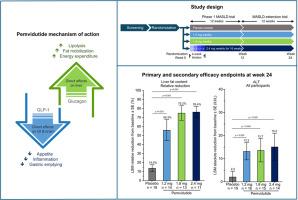Safety and efficacy of 24 weeks of pemvidutide in metabolic dysfunction-associated steatotic liver disease: A randomized, controlled clinical trial
IF 7.5
1区 医学
Q1 GASTROENTEROLOGY & HEPATOLOGY
引用次数: 0
Abstract
Background & Aims
This was a double-blind 12-week extension of a randomized, placebo-controlled, 12-week trial of pemvidutide, a glucagon-like peptide-1/glucagon dual receptor agonist, in individuals with metabolic dysfunction-associated steatotic liver disease (MASLD).
Methods
Completers of a double-blind trial of pemvidutide in MASLD, who were previously randomized 1:1:1:1 to pemvidutide at 1.2 mg, 1.8 mg, or 2.4 mg, or placebo administered subcutaneously once weekly for 12 weeks, were offered an additional 12 weeks of treatment at their originally assigned dose for a total of 24 weeks of treatment. Participants were stratified by the presence or absence of type 2 diabetes mellitus (T2DM). The primary efficacy endpoint was relative reduction (%) from baseline in liver fat content by magnetic resonance imaging-proton density fat fraction after 24 weeks of treatment.
Results
There were 64 participants in the extension trial. Baseline mean values for BMI and liver fat content were 36.7 kg/m2 and 22.2%; 26.6% of participants had T2DM. After 24 weeks of treatment, pemvidutide achieved relative reductions in liver fat content from baseline of 56.3%, 75.2%, and 76.4% for the pemvidutide 1.2 mg, 1.8 mg, and 2.4 mg groups respectively, vs. 14.0% for placebo (p <0.001 vs. placebo, all treatment groups), with 84.6% of participants achieving 50% reductions in liver fat content and 53.8% achieving normalization (≤5% liver fat content) at the 1.8 mg dose. Body weight was also reduced by 6.2% (p <0.001 vs. placebo) over 24 weeks of treatment. Pemvidutide was well-tolerated at all doses, with low incidences of side effects.
Conclusions
In individuals with MASLD, 24 weeks of pemvidutide treatment resulted in significant reductions in liver fat content and body weight that further improved upon the effects observed at 12 weeks.
Impact and implications
Overweight and obesity are strongly associated with metabolic dysfunction-associated steatotic liver disease and metabolic dysfunction-associated steatohepatitis (MASH), as the excess liver fat associated with obesity is a known driver of these conditions. Glucagon-like peptide-1 receptor (GLP-1R) agonists elicit weight loss through centrally and peripherally mediated effects on appetite, whereas G-coupled glucagon receptor (GCGR) agonists act directly on the liver to stimulate fatty acid oxidation and inhibit lipogenesis, providing a more potent mechanism for reducing liver fat content than weight loss alone. We previously showed that once-weekly treatment with pemvidutide, a dual GLP-1R/GCGR agonist, significantly reduced liver fat content, hepatic inflammatory activity, and body weight over 12 weeks. The current trial demonstrates that continued treatment with pemvidutide further improves these clinical markers of MASH.
Clinical Trials Registration
The study is registered at ClinicalTrials.gov (NCT05292911).

24周培维肽治疗代谢功能障碍相关脂肪变性肝病的安全性和有效性:一项随机对照临床试验
本研究是一项为期12周的随机、安慰剂对照、针对代谢功能障碍相关脂肪变性肝病(MASLD)患者的胰高血糖素样肽-1/胰高血糖素双受体激动剂——派维肽的双盲试验的延续。方法:在一项针对MASLD的双盲试验中,先前以1:1:1:1的比例随机分配给1.2 mg、1.8 mg或2.4 mg的培维多肽,或每周皮下注射一次的安慰剂,持续12周,在最初指定的剂量下再给予12周的治疗,总共24周的治疗。参与者根据是否患有2型糖尿病(T2DM)进行分层。主要疗效终点是治疗24周后磁共振成像-质子密度脂肪分数显示的肝脏脂肪含量相对基线降低(%)。结果扩展试验共纳入64例受试者。BMI和肝脏脂肪含量基线平均值分别为36.7 kg/m2和22.2%;26.6%的参与者患有2型糖尿病。治疗24周后,培维肽1.2 mg、1.8 mg和2.4 mg组的肝脂肪含量相对于基线分别降低了56.3%、75.2%和76.4%,安慰剂组为14.0% (p <;0.001与安慰剂相比,所有治疗组),在1.8 mg剂量下,84.6%的参与者肝脏脂肪含量降低了50%,53.8%的参与者肝脏脂肪含量达到正常化(≤5%)。在24周的治疗期间,体重也减少了6.2% (p <;0.001与安慰剂相比)。培维多肽在所有剂量下耐受性良好,副作用发生率低。结论:在MASLD患者中,培维肽治疗24周后,肝脏脂肪含量和体重显著降低,在12周的基础上进一步改善。影响和意义超重和肥胖与代谢功能障碍相关的脂肪性肝病和代谢功能障碍相关的脂肪性肝炎(MASH)密切相关,因为与肥胖相关的过量肝脏脂肪是这些疾病的已知驱动因素。胰高血糖素样肽-1受体(GLP-1R)激动剂通过中枢和外周介导的食欲作用引起体重减轻,而g偶联胰高血糖素受体(GCGR)激动剂直接作用于肝脏刺激脂肪酸氧化和抑制脂肪生成,提供了比单独减肥更有效的降低肝脏脂肪含量的机制。我们之前的研究表明,每周一次使用双GLP-1R/GCGR激动剂培维肽治疗,在12周内显著降低肝脏脂肪含量、肝脏炎症活性和体重。目前的试验表明,继续使用培维肽可进一步改善MASH的这些临床指标。临床试验注册本研究已在ClinicalTrials.gov注册(NCT05292911)。
本文章由计算机程序翻译,如有差异,请以英文原文为准。
求助全文
约1分钟内获得全文
求助全文
来源期刊

JHEP Reports
GASTROENTEROLOGY & HEPATOLOGY-
CiteScore
12.40
自引率
2.40%
发文量
161
审稿时长
36 days
期刊介绍:
JHEP Reports is an open access journal that is affiliated with the European Association for the Study of the Liver (EASL). It serves as a companion journal to the highly respected Journal of Hepatology.
The primary objective of JHEP Reports is to publish original papers and reviews that contribute to the advancement of knowledge in the field of liver diseases. The journal covers a wide range of topics, including basic, translational, and clinical research. It also focuses on global issues in hepatology, with particular emphasis on areas such as clinical trials, novel diagnostics, precision medicine and therapeutics, cancer research, cellular and molecular studies, artificial intelligence, microbiome research, epidemiology, and cutting-edge technologies.
In summary, JHEP Reports is dedicated to promoting scientific discoveries and innovations in liver diseases through the publication of high-quality research papers and reviews covering various aspects of hepatology.
 求助内容:
求助内容: 应助结果提醒方式:
应助结果提醒方式:


